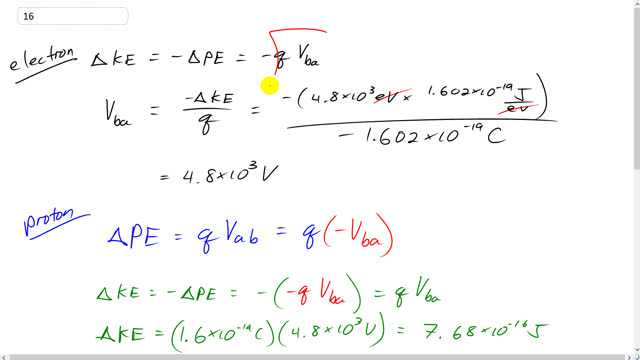
An electron starting from rest acquires 4.8 keV of KE in moving from point A to point B.
- How much KE would a proton acquire, starting from rest at B and moving to point A?
- Determine the ratio of their speeds at the end of their respective trajectories.

In order to watch this solution you need to have a subscription.
This is Giancoli Answers with Mr. Dychko. So this electron has a change in kinetic energy which is the opposite to its change of potential energy or the negative, I should say. And that makes it the negative of the charge times the potential difference between an initial position A and a final position B. So we can solve for this V ba which we're going to then use down here to find the change in potential energy for the proton which then leads us to find the change in kinetic energy of the proton, by dividing both sides by negative q here and we get V ba is negative change in kinetic energy over q. So that's a negative of 4.8 times ten to the three electron volts times 1.602 times ten to the minus 19 joules per electron volt, to convert the top into joules and divide by the charge on the electron, negative 1.602 times ten to the minus 19 coulombs, we get 4.8 times ten to the three volts has a potential difference between A and B. So B having the higher potential and now if we put a proton starting at position B and ending at position A, this potential difference is going to be the opposite to the potential difference going the other direction. So that is to say that if you had a… let's get this eraser working, if you had V ab is… so this goes initial and then final so it's going to be V a minus V b. So, this is what we want for the calculating the change in potential for the proton and that's going to equal the opposite or the negative of V b minus V a. I mean if you put the negatives... if you distribute the negative into the brackets, you get a negative V b and a positive V a as you have here. So these are equal. And and this is V ba which is what we just figured out for the electron. So we have the negative of V ba which is what I substituted here in place of V ab so change in kinetic energy of the proton is the negative of his change in potential. And so that's the negative of negative q V ba which is positive q V ba and that's 1.6 times ten to the negative 19 coulombs times 4.8 times ten to the three volts which is 7.68 times ten to the negative 16 joules and if you multiply that by one electron volt for every element to recharge joules that's 1.6 times ten to the minus 19 right there. That'll cancel with this one, you're left with this number. So change in kinetic energy is 4.8 times ten to the three electron volts. This is no surprise because the proton has the same charge as the electron and it's gonna get accelerated through the same potential difference and so we'd expect it's change in kinetic energy to be the same. So how about the ratio of speeds. So we know that the… Well since they both started at rest. That means this change in kinetic energy is actually the final kinetic energy and and that of the electron is the same as that of the proton so we have one half mass of electron times electrons final velocity squared is equal to one half mass of the proton times the protons final velocity squared and the one halves cancel and you can divide both sides by m e and divide both sides by v p squared and then you're left with v e squared over v p squared equals m p over m e and then take the square root of both sides and we end up with this line here. And so the ratio of speed is the square root of the ratio of the masses. I guess inversely because you have the velocity of the electron over velocity of the proton is a square root of the mass of the proton over the mass of electrons so they're opposite order here so we have a square root 1.67 times ten to the minus 27 kilograms divided by 9.11 times ten to the minus 31 kg and we get 42.8. So the velocity of electron is 42.8 times faster than that of the proton.
Why did you choose to arrange the equation for the ratio of their speeds as ve/vp?